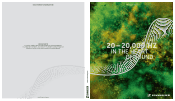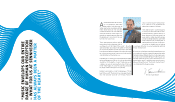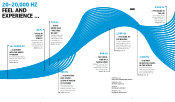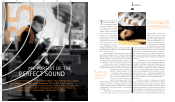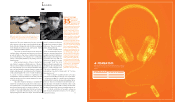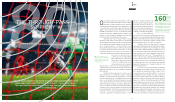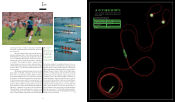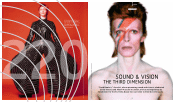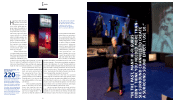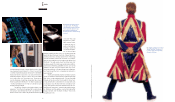Sennheiser 2012 Annual Report Download - page 5
Download and view the complete annual report
Please find page 5 of the 2012 Sennheiser annual report below. You can navigate through the pages in the report by either clicking on the pages listed below, or by using the keyword search tool below to find specific information within the annual report.
0908
20–20,000 Hz
There are sounds that touch
the soul. Sounds that com-
fort, strengthen and raise
us up. A good sound has charis-
ma. Though “charis” literally
means “grace,” it also means
“beauty’s charm.” Finding the
perfect sound has become my
purpose in life – a journey that
has taken me into the heart of
sound. In order to set off on that
journey, however, I had to leave
music school and enter a school
for violinmaking. To move for-
ward, I studied physics. And to
get there, I dared the impossible – to create a sound that no
instrument in the world has ever produced. But my journey
has not yet come to an end.
Others may have finished their journeys. Such as the
great Italian violinmakers Antonio Stradivari and Joseph
Guarneri del Gesù. The secrets they took with them to the
grave are inimitable – even to this day. Their instruments
are not just works of art valued at millions of dollars – they
are being played to this day by the world’s greatest virtuosi.
But how is that possible? It’s a question I’ve been
asking myself since I was seven years old, when I was at-
tending a small music school in Swabia. Music is my life. We
played music at home on Sundays. I’ve
played in a chamber orchestra, a hard
rock band and in the pedestrian zone.
We even built our own tube amp. But
the rest of the time, I was at school, lis-
tening to the constant answers to
questions I had never asked. That’s
why I left the music school after the 10th grade and began
studying to be a luthier – a violinmaker. Driving me on was
a dream of building instruments with a better sound than
a Stradivarius and – should I not succeed – to find out why
it wasn’t possible.
Did the masters of the 18th century have some kind
of secret knowledge? Or was it the wood’s aging process
that gave their instruments the
kind of mature sound a young
instrument could never achieve?
The violin originated during one
of the most remarkable eras of
all times. For the great masters
of the Renaissance, combining
art and science was just a matter
of fact. It is unfathomable to think of such artistic works
being created without this special attention to detail and
feel for nature. It requires an environment of gifted em-
piricism and holistic intuition to design such highly opti-
mized acoustical systems. In the 19th century, however, the
art of violinmaking fell prey to the trade of the industrial
revolution.
The guild had sold its soul. But how would I manage
to reconnect to the art of sound? I first began by trying out
countless of the different recipes used to make traditional
varnishes. However, it soon became clear to me that the old
masters would have combined science without forfeiting art
– just as acoustician Helmut Müller taught me. A physics
teacher at my violinmaking school, he operated a research
laboratory at his acoustic consulting firm Müller-BBM. It was
in his laboratory that I was able to pursue the answers to all
the unresolved questions I had tortured him with for so
many years.
And then, a revelation: modal analysis. A method
used in aerospace technology. I was the first one to apply it
to the violin. At last, it was possible to actually see how the
violin vibrates. The bulbous breathing in the lowest natural
frequency – the Helmholtz resonance around 260 to 280 Hz.
The strong distortion of the lower corpus resonances, the
extensive motion of the plates and their two main reso-
nances 440 and 550 Hz, and their wide deviations around
35
ESSAY
e1. The master at work:
Schleske’s studio is located
in a nature reserve. When
he opens his window, he
can hear the sound of a
babbling brook.
e1. Historical scrolls and peg boxes: Our author
has been studying historical violins from the
18th century for decades. g2. Carving a violin:
The inspired sound researcher hews the tone-
wood himself. In the laboratory, he applies var-
nishes he has prepared according to traditional
recipes.
MY PURSUIT OF THE
PERFECT SOUND
From the lowest depths to the highest heights: Music envelops the complete
spectrum of sound audible to the human ear: 20–20,000 Hz. But which of
these resonances are able to touch our souls? German Martin Schleske, one
of the best luthiers in the world, is in hot pursuit of the answer. In this essay,
he describes his unique journey into the heart of sound.

